The Westminster Hall debate on waste tyres, tabled by Tessa Munt Lib Dem MP for Wells and Mendip Hills raised the profile of the tyre export issue, though perhaps not as robust as some may have hoped, the debate has raised the profile of the export issue
Westminster Hall debates take place in Westminster Hall, not the House of Commons. They create an opportunity for issues to be discussed with Ministers and questions to be posed. The Minister representing DeFRA was Mary Creagh MP.
The introduction to the discussion was made by Tessa Munt, highlighting the need for a circular economy. Munt reminded the room of the revelations of the BBC investigation and added that of bales tracked from both the UK and Australia, 100% of the tracked bales did not go to the intended legitimate destination but were redirected to illegally be pyrolysed in some very dirty circumstances.

Sarah Dyke Lib Dem for Glastonbury and Somerton supported the debate, asking; “Does my hon. Friend agree that urgent Government investment in tyre recycling infrastructure is needed to tackle the environmental hazards posed by worn tyres?”
Munt continued; “This Minister knows that it is not sufficient to talk about the circular economy; she and her team need to take action to deliver the changes that have been talked about for far too long.”
There followed an outlining of what happens to UK tyre arisings in this unregulated market. Then came the question; “What is the Minister’s view on a potential producer responsibility scheme for the UK’s end of life tyres?”

Munt then focused on the current situation with the Environment Agency; “In response to the legal challenge and the BBC documentary, the Government have announced that the Environment Agency will conduct a review into the issue. Today I seek clarification from the Minister about the scope of that review, and I have four questions at this point. Will the review be limited to an assessment of the enforcement of the existing legal provisions contained in the Basel convention and the waste shipments regulations? Will the review enable the Environment Agency to consider policy improvements? Will the review make policy recommendations to Ministers? How and when does the review intend to engage with the industry and interested parties?
“The Environment Act 2021 significantly strengthened the powers available to the Government to manage and track waste exports. Section 62 of the Act added to the provisions of the Environmental Protection Act 1990 by creating further regulatory powers to better manage and track waste exports and the countries they pass through. It also established additional powers of direction for Ministers. As I understand it, those important new powers have yet to be used.”
Then the discussion came to the crux of the problem, the T8 Exemptions. Munt asked; “Will the Minister use her new powers under section 62 of the 2021 Act to take action to address the problems with waste tyre exports? Because end-of-life tyres are currently deemed green list waste under assimilated law through the waste shipments regulations, they are not notifiable and, as a result, are difficult to track. Will the Minister confirm that she will amend the waste shipments regulations to remove end-of-life tyres from the green list category and make such exports notifiable?”
There followed an outline of the Australian experience and how the requirement for exporters to be licensed and the whole tyre export ban had virtually overnight brought an end to Australian exports of whole tyres to India – removing the risk of those tyres being salvaged and resold for use on the road.
Munt than asked her final questions; “I have three more questions for the Minister. If we are to adopt the circular economy agenda, should we not support investors who want to recycle end-of-life tyres here? Does she agree that we should take steps to ensure that UK companies have a domestic feedstock to give them confidence? Finally, does she agree that we should take responsibility for our own waste, process it here in the UK and maximise the economic value of that resource? The Australian model for end-of-use tyres seems good and effective, and we could easily replicate its impact and effect with relatively minor changes.”
The Parliamentary Under-Secretary of State for Environment, Food and Rural Affairs, Mary Creagh responded in the style that we have all become accustomed to from minsters of any shade over the past 10 years; “What a joy it is to be back in Westminster Hall to discuss everybody’s favourite subjects: the materials economy, waste crime, and how we are going to tackle waste crime, after a decade and a half of a lot of talk and very little action—as the Elvis Presley song goes. We will have a little more action under this Government. As part of our plan for change, we will clean up Britain, crack down on waste cowboys and close the waste loopholes. I am keen that we all work together on a cross-party basis to achieve that.”

In that response, plus ca change. That is what is always said. It is a catch-all response that makes no commitment to anything in particular.
There followed a bit of to and fro, and then Sarah Dyke offered this; “In 2021, Natural England downgraded the Somerset levels and moors Ramsar area and the water quality there to “unfavourable declining”. Somerset Wildlife Trust has attributed the microplastics to worn tyres in the environment. It is obviously a really concerning pollutant. What steps is the Minister taking to make manufacturers take greater responsibility for the contribution that their products make to microplastic pollution on the Somerset levels and moors?”
To observers familiar with the tyre industry the response from a minister of state was surprising, Creagh responded; “That is a really interesting fact, and not one that I have come across. I will take that away and look at it.”
Perhaps, we in the tyre sector live in a little bubble, but the question of tyre wear particles and rubber microplastics in the environment has been across the media for several years. Leading to the EU ban on crumb rubber infill in Europe. How could a Minister from DeFRa not be aware of the issue?
In a slightly diversionary response, Mary Creagh talked about the inconsistencies within the UK, and the possibility (reality) that tyres from Scotland were shipped to England for export. She did not discuss to issues in Northern Ireland where cross border disposal still takes place illicitly.
There was some talk from Mary Creagh of the Circular Economy Task Force and the suggestion that the tyre recovery Association should feed into one of the working streams.
Mary Creagh started winding up her response by saying; “The principle of fairness is important, as is enforcement of the law as it stands—before we make new laws, we should look at enforcing the laws we already have.”
The first part of that statement is absolutely what is being asked for by bona fide collectors and recyclers. Then things start to fall apart. The enforcement of the law as it stands is absolutely where the system is failing. The abuse of the free to obtain T8 Exemption has resulted in the Environment Agency not having the funds to inspect. Equally, the delay in the introduction of digital waste tracking has allowed evasion of tracking and abuse of the T8 to continue unabated.
Unless the system is changed, and the EA given the funding to inspect and regulate the T8 Exemptions, then nothing will change. When asked about the number of T8 Exemption in place, the EA responded that there were in excess of 6,000 T8 Exemptions, many of them agricultural, many of them dormant, but they had no way of checking any of these Exemptions unless there was an environmental crime or pollution issue reported. Their responses were almost invariably reactive, after the fact. That has to change.

















